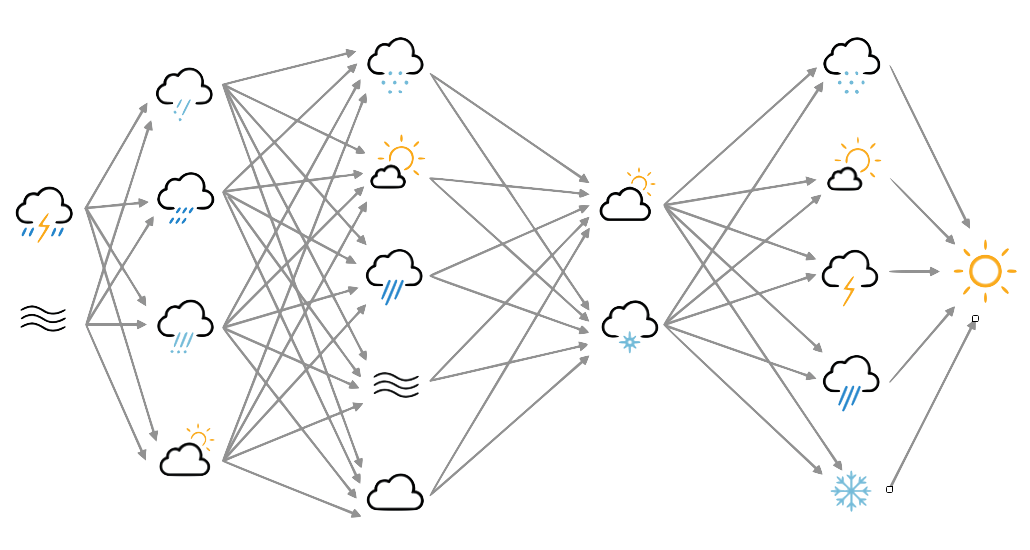Plot one frame from the MO global analysis video¶
The video shows temperature, wind, and precipitation. Getting three variuables into one image requires some care in presentation, particularly in the choice of colours used.
- The temperature is a colour map. It is quantile normalised - that is, the temperature field is scaled so that it’s distribution is flat - this means that the image shows the same amount of each colour. Also, the temperatures are adjusted to enhance the weather variability, and supress the climatological variability and the diurnal cycle (the temperature anomalies are doubled, and the diurnal cycle reduced to 1/4 of it’s real size). This allows diurnal variability, the annual cycle, fixed effects like orography and the gulf stream, and weather-timescale variability, all to be shown in the same plot, without any one component dominating.
- Precipitation is only shown where it exceeds a threshold value (very light precipitation is missing). It is plotted on a log scale, using the ‘algae’ colour scale from cmocean, adjusted to taper to transparency at the bottom end.
- Wind is shown as advected speckles - a random field advected along with the wind vectors - this turns the speckles into stripes in the direction of the wind. They can be made to move from frame to frame by advecting most them a little more each timestep (and resetting a few of them to zero advection). This is plotted by adding the wind field to the temperature and precipitation fields before plotting them. The field has mean zero so it has no average effect, but it perturbs the other fields in a way which shows the wind structure.
Script to make a single frame:
#!/usr/bin/env python
# Atmospheric state - near-surface temperature, wind, and precip.
import os
import sys
import IRData.opfc as opfc
import datetime
import pickle
import iris
import numpy
import matplotlib
from matplotlib.backends.backend_agg import FigureCanvasAgg as FigureCanvas
from matplotlib.figure import Figure
from matplotlib.patches import Rectangle
from matplotlib.lines import Line2D
from pandas import qcut
from load_step import load_recent_temperatures
from load_step import load_li_precip
from load_step import load_di_icec
sys.path.append('%s/../../lib/' % os.path.dirname(__file__))
from plots import quantile_normalise_t2m
from plots import plot_cube
from plots import make_wind_seed
from plots import wind_field
from plots import get_precip_colours
from plots import draw_lat_lon
# Fix dask SPICE bug
import dask
dask.config.set(scheduler='single-threaded')
import argparse
parser = argparse.ArgumentParser()
parser.add_argument("--year", help="Year",
type=int,required=True)
parser.add_argument("--month", help="Integer month",
type=int,required=True)
parser.add_argument("--day", help="Day of month",
type=int,required=True)
parser.add_argument("--hour", help="Time of day (0 to 23.99)",
type=float,required=True)
parser.add_argument("--pole_latitude", help="Latitude of projection pole",
default=90,type=float,required=False)
parser.add_argument("--pole_longitude", help="Longitude of projection pole",
default=180,type=float,required=False)
parser.add_argument("--npg_longitude", help="Longitude of view centre",
default=0,type=float,required=False)
parser.add_argument("--zoom", help="Scale factor for viewport (1=global)",
default=1,type=float,required=False)
parser.add_argument("--opdir", help="Directory for output files",
default="%s/images/opfc_global_3var_meanp" % \
os.getenv('SCRATCH'),
type=str,required=False)
args = parser.parse_args()
if not os.path.isdir(args.opdir):
os.makedirs(args.opdir)
dte=datetime.datetime(args.year,args.month,args.day,
int(args.hour),int(args.hour%1*60))
# In the temperature field, damp the diurnal cycle, and
# boost the short-timescale variability. Load the
# recent data to calculate this.
(tavg,davg) = load_recent_temperatures(dte)
# Load the model data
t2m=opfc.load('air.2m',dte,model='global')
# Remove the diurnal cycle
t2m.data -= davg.data
# Double the synoptic variability
t2m.data += (t2m.data-tavg.data)*1
# Add back a reduced diurnal cycle
t2m.data += davg.data*0.25
u10m=opfc.load('uwnd.10m',dte,model='global')
v10m=opfc.load('vwnd.10m',dte,model='global')
# We're plotting log precip - so interpolate in log space too
precip=load_li_precip(dte)
mask=iris.load_cube("%s/fixed_fields/land_mask/opfc_global_2019.nc" %
os.getenv('SCRATCH'))
# Icec is only daily, so interpolate manually
icec=load_di_icec(dte)
# Remap the t2m to highlight small differences
t2m=quantile_normalise_t2m(t2m)
t2m *= 1000
# Define the figure (page size, background color, resolution, ...
fig=Figure(figsize=(38.4,21.6), # Width, Height (inches)
dpi=100,
facecolor=(0.5,0.5,0.5,1),
edgecolor=None,
linewidth=0.0,
frameon=False, # Don't draw a frame
subplotpars=None,
tight_layout=None)
fig.set_frameon(False)
# Attach a canvas
canvas=FigureCanvas(fig)
# Make the wind noise
wind_pc=plot_cube(0.2,-180/args.zoom,180/args.zoom,
-90/args.zoom,90/args.zoom)
cs=iris.coord_systems.RotatedGeogCS(90.0,180.0,0.0)
rw=iris.analysis.cartography.rotate_winds(u10m,v10m,cs)
u10m = rw[0].regrid(wind_pc,iris.analysis.Linear())
v10m = rw[1].regrid(wind_pc,iris.analysis.Linear())
seq=(dte-datetime.datetime(2000,1,1)).total_seconds()/3600
z=make_wind_seed(0.4,seed=1)
wind_noise_field=wind_field(u10m,v10m,z,sequence=int(seq*5),epsilon=0.01)
# Define an axes to contain the plot. In this case our axes covers
# the whole figure
ax = fig.add_axes([0,0,1,1])
ax.set_axis_off() # Don't want surrounding x and y axis
# Lat and lon range (in rotated-pole coordinates) for plot
ax.set_xlim(-180/args.zoom,180/args.zoom)
ax.set_ylim(-90/args.zoom,90/args.zoom)
ax.set_aspect('auto')
# Background
ax.add_patch(Rectangle((0,0),1,1,facecolor=(0.6,0.6,0.6,1),fill=True,zorder=1))
# Draw lines of latitude and longitude
draw_lat_lon(ax,lwd=0.75,
pole_longitude=args.pole_longitude,
pole_latitude=args.pole_latitude,
npg_longitude=args.npg_longitude)
# Plot the land mask
mask_pc=plot_cube(0.05,-180/args.zoom,180/args.zoom,
-90/args.zoom,90/args.zoom)
mask = mask.regrid(mask_pc,iris.analysis.Linear())
lats = mask.coord('latitude').points
lons = mask.coord('longitude').points
mask_img = ax.pcolorfast(lons, lats, mask.data,
cmap=matplotlib.colors.ListedColormap(
((0.4,0.4,0.4,0),
(0.4,0.4,0.4,1))),
vmin=0,
vmax=1,
alpha=1.0,
zorder=20)
# Plot the sea-ice
ice_pc=plot_cube(0.05,-180/args.zoom,180/args.zoom,
-90/args.zoom,90/args.zoom)
icec = icec.regrid(ice_pc,iris.analysis.Linear())
icec_img = ax.pcolorfast(lons, lats, icec.data,
cmap=matplotlib.colors.ListedColormap(
((0.5,0.5,0.5,0),
(0.5,0.5,0.5,1))),
vmin=0,
vmax=1,
alpha=1.0,
zorder=10)
# Plot the T2M
t2m_pc=plot_cube(0.05,-180/args.zoom,180/args.zoom,
-90/args.zoom,90/args.zoom)
t2m = t2m.regrid(t2m_pc,iris.analysis.Linear())
# Adjust to show the wind
wscale=200
s=wind_noise_field.data.shape
wind_noise_field.data=qcut(wind_noise_field.data.flatten(),wscale,labels=False,
duplicates='drop').reshape(s)-(wscale-1)/2
# Plot as a colour map
wnf=wind_noise_field.regrid(t2m,iris.analysis.Linear())
t2m_img = ax.pcolorfast(lons, lats, t2m.data+wnf.data,
cmap='RdYlBu_r',
vmin=-100,
vmax=1100,
alpha=0.8,
zorder=100)
# Plot the precip
precip_pc=plot_cube(0.25,-180/args.zoom,180/args.zoom,
-90/args.zoom,90/args.zoom)
precip = precip.regrid(precip_pc,iris.analysis.Linear())
wnf=wind_noise_field.regrid(precip,iris.analysis.Linear())
precip.data += wnf.data/1000
cols=get_precip_colours()
precip_img = ax.pcolorfast(lons, lats, precip.data,
cmap=matplotlib.colors.ListedColormap(cols),
vmin=0,
vmax=1,
alpha=0.8,
zorder=200)
# Label with the date
ax.text(180/args.zoom-(360/args.zoom)*0.009,
90/args.zoom-(180/args.zoom)*0.016,
"%04d-%02d-%02d" % (args.year,args.month,args.day),
horizontalalignment='right',
verticalalignment='top',
color='black',
bbox=dict(facecolor=(0.6,0.6,0.6,0.5),
edgecolor='black',
boxstyle='round',
pad=0.5),
size=28,
clip_on=True,
zorder=500)
# Render the figure as a png
fig.savefig('%s/%04d%02d%02d%02d%02d.png' % (args.opdir,args.year,
args.month,args.day,
int(args.hour),
int(args.hour%1*60)))
Library and utility functions used:
